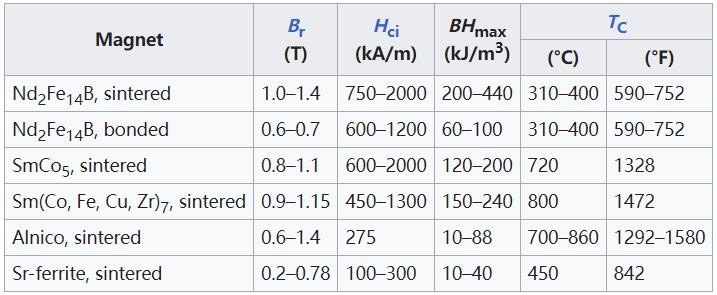A neodymium magnet (also known as NdFeB, NIB or Neo magnet) is the most widely used type of rare-earth magnet. It is a permanent magnet made from an alloy of neodymium, iron, and boron to form the Nd2Fe14B tetragonal crystalline structure. Developed independently in 1984 by General Motors and Sumitomo Special Metals, neodymium magnets are the strongest type of permanent magnet available commercially. NdFeB magnets can be classified as sintered or bonded, depending on the manufacturing process used. They have replaced other types of magnets in many applications in modern products that require strong permanent magnets, such as electric motors in cordless tools, hard disk drives and magnetic fasteners.
Properties
Grades
Neodymium magnets are graded according to their maximum energy product, which relates to the magnetic flux output per unit volume. Higher values indicate stronger magnets. For sintered NdFeB magnets, there is a widely recognized international classification. Their values range from N28 up to N55. The first letter N before the values is short for neodymium, meaning sintered NdFeB magnets. Letters following the values indicate intrinsic coercivity and maximum operating temperatures (positively correlated with the Curie temperature), which range from default (up to 80 °C or 176 °F) to TH (230 °C or 446 °F).
Grades of sintered NdFeB magnets:
- N30 – N55
- N30M – N50M
- N30H – N50H
- N30SH – N48SH
- N30UH – N42UH
- N28EH – N40EH
- N28TH – N35TH
Magnetic properties
Some important properties used to compare permanent magnets are:
- Remanence (Br), which measures the strength of the magnetic field.
- Coercivity (Hci), the material’s resistance to becoming demagnetized.
- Maximum energy product (BHmax), the density of magnetic energy, characterized by the maximum value of magnetic flux density(B) times magnetic field strength (H).
- Curie temperature (TC), the temperature at which the material loses its magnetism.
Neodymium magnets have higher remanence, much higher coercivity and energy product, but often lower Curie temperature than other types of magnets. Special neodymium magnet alloys that include terbium and dysprosium have been developed that have higher Curie temperature, allowing them to tolerate higher temperatures. The table below compares the magnetic performance of neodymium magnets with other types of permanent magnets.
Physical and mechanical properties
| Property | Neodymium | Sm-Co |
|---|---|---|
| Remanence (T) | 1–1.5 | 0.8–1.16 |
| Coercivity (MA/m) | 0.875–2.79 | 0.493–2.79 |
| Recoil permeability | 1.05 | 1.05–1.1 |
| Temperature coefficient of remanence (%/K) | −(0.12–0.09) | −(0.05–0.03) |
| Temperature coefficient of coercivity (%/K) | −(0.65–0.40) | −(0.30–0.15) |
| Curie temperature (°C) | 310–370 | 700–850 |
| Density (g/cm3) | 7.3–7.7 | 8.2–8.5 |
| Thermal expansion coefficient, parallel to magnetization (1/K) | (3–4)×10−6 | (5–9)×10−6 |
| Thermal expansion coefficient, perpendicular to magnetization (1/K) | (1–3)×10−6 | (10–13)×10−6 |
| Flexural strength (N/mm2) | 200–400 | 150–180 |
| Compressive strength (N/mm2) | 1000–1100 | 800–1000 |
| Tensile strength (N/mm2) | 80–90 | 35–40 |
| Vickers hardness (HV) | 500–650 | 400–650 |
| Electrical resistivity (Ω·cm) | (110–170)×10−6 | (50–90)×10−6 |
Post time: Jun-05-2023
 Email:sales@liftsunmagnets.com
Email:sales@liftsunmagnets.com WhatsApp:+8618989333792
WhatsApp:+8618989333792 Sign In or Create an Account
Sign In or Create an Account

